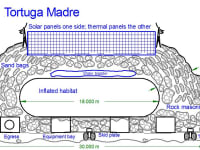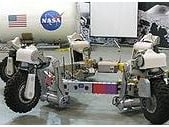I have some bad news: every depiction of people in space that you have ever seen, every movie, every SF short story, is complete rubbish! Reality has shot down our dreams.
This problem jumped out at us from new data on radiation safety for humans in space, this is just in from NASA's LRO mission. This data was used to revise NASA's radiation hazard model, which now shows that the radiation hazard is about twice what we previously designed for.
The good news is: we can fix the problem.
This new understanding of radiation hazard forces us to rethink our top-level designs of long-term human activity in space. The most dangerous radiation is Galactic Cosmic Rays (GCR), which deeply penetrate shielding, thus generating secondary radiation that must also be stopped. Humans will need to live under a shielding mass comparable to the Earth's atmosphere over a high-altitude city like Denver.
For lunar exploration there is a ready answer: build our shield from the rocks and regolith of the Moon herself. An all-purpose shield (radiation, thermal, and micrometeorite) made from local materials will need to be about 5 meters thick (20 feet, see Figure 2). This is a difficult task, one which will necessitate a rethinking of lunar construction.
Humans have built with rock for tens of thousands of years. We can certainly build with rock on the Moon. For this new vision of lunar construction, we will need new tools, new software, and a space cement.
One of these tools must be a small robotic mason. It must be able to collect usable stones, scan them in 3D, and carry them to a boneyard. It must work in a very difficult environment of 1/6 G on a surface covered with fine dust. Our Robomason will then select the correct rock for a task, grid small flat surfaces on it, apply dabs of space cement, and put the rock into place, often several meters high.
We can begin this work by assembling with a cairn, a stack of rock used my many civilizations to mark the way. We will move up to arches, then to vaults that can span and entomb an inflatable habitat for humans. Over this stone vault our Robomasons must stack bags of lunar sand, called regolith, to build up to the 5-meter shield requirement.
We can then take on the harder challenge, a fully shielded lunar rover. Starting from a wheeled platform (Figure 3) with a net base, the Robomasons will build a vault over a self-contained habitat. They will then attach regolith bags and add external features like solar and thermal panels, equipment bays, and an egress. The interior will be a man-cave lined with large monitors that display the lunar panorama, but can also run any game, movie, or computer program; Figure 1, Toruga Madre the Mother Turtle.
Sometimes reality forces us to start over and completely rethink what we are doing. Just sometimes that rethinking can lead to a brave new place.
Like this entry?
-
About the Entrant
- Name:Tom Riley
- Type of entry:individual
- Software used for this entry:AutoSketch
- Patent status:none








